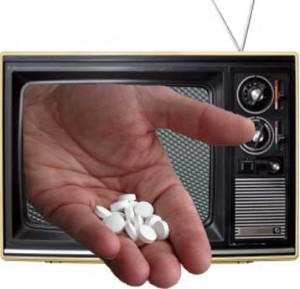Pushing Pills: DTC Prescription Drug Advertising
By Hanna Bailey // June 22, 2012
Pharmacy Update
(Video by PfefferProductions)
SPACECOASTMEDICINE.COM–Have you noticed the multiple advertisements on television promoting prescription drugs to consumers? Every commercial segment is filled with these ads that encourage patients to take charge of their disease state. In addition, these advertisements convince viewers that the promoted medication may fit their needs.
Direct-To-Consumer Advertising

Direct-to-consumer advertising (DTCA) is the promotion of prescription drugs to consumers through the use of mass media such as television, newspapers, magazines, and the internet. Drug manufacturers also market their products by producing videos and brochures that are distributed to patients by health care professionals. Aside from DTCA, pharmaceutical companies promote brand-name prescription drugs to health care professionals through advertisements in medical journals, publications of favorable studies, pharmaceutical company visits to physician offices, provision of free drugs samples, and sponsorship of educational conferences.
The United States and New Zealand are the only countries in the world that allow DTCA. DTCA was legalized in the United States in the mid 1980s, however, it largely became more prevalent in 1997 when the Food and Drug Administration (FDA) eased the restrictions on the detailed list of drug side effects. There has been a persistent increase in the amount of money spent by pharmaceutical companies on DTCA.

According to recent statistics, the pharmaceutical industry spends approximately 5 billion dollars on this form of marketing each year. As a result of DTCA, there has been an increase in overall spending on prescription drugs. Surveys show that of those people who view DTCA, two to seven percent of consumers are prescribed the advertised medication upon request.
DTCA Controversial
There has been considerable controversy regarding direct-to-consumer advertising since prescription drug ads started airing on television. Proponents of DTCA state that these advertisements benefit consumers in several ways. First, DTCA serves to educate patients about their disease states and raises awareness about potential treatment options. Secondly, it promotes the development of patient autonomy; advertising can entice patients to begin taking part in decisions regarding their health through an informed conversation with their physicians. Patients become more aware of potential health problems and are likely to recognize these problems much earlier.
Listing disease-specific symptoms in ads may help uncover an underlying health issue that a patient may be experiencing. The pharmaceutical industry claims that resultant earlier diagnosis and treatment equates to lower overall medical costs, including costs due to disability and hospitalization. Drug advertisements can also improve patient adherence to their medication by serving as an additional reminder for patients to take their medication.

However, despite all of the purported benefits that DTCA may offer, this aggressive style of prescription drug promotion has met with considerable criticism as well. Opponents of DTCA state that advertisements may be misleading to consumers. From 1997 to 2006, 84% of FDA regulatory letters concerning DTCA cited those ads for either exaggerating the effectiveness of a drug, minimization of therapy risks, or both.
Critics of DTCA point out that prescription drug ad campaigns often begin within one year of FDA drug approval for patient use. The advertisements are often appealing and emotional in nature, but the description of side effects occurs either during frequent scene changes with an increased speed in the announcer’s narration or scrolled along the bottom of the screen. This can result in viewer distraction from what may be important information.
Pharmaceutical companies also employ celebrities in the advertisements for their products in order to appeal to consumers. Frequent advertising of new drugs can result in an increase in prescribing, especially in the use of drugs with safety profiles that may not be fully established. Lastly, critics state that DTCA can lead to potential overuse of medications through prescribing of inappropriate or unnecessary therapies.
Candid Dialogue With Physician Is Imperative

In the end, DTCA advertising has led to a more empowered patient. However, with the wealth of information presented in mass media, it is highly advisable that consumers watching drug advertisements have an open discussion with their health care professionals regarding the most suitable therapy to improve their health-related outcomes. Patients are encouraged to ask their doctor if a certain medication would be appropriate for them. In addition, patients can speak with their pharmacist about the potential risks of drug therapy and warning signs prior to starting a new medication.
ABOUT THE AUTHOR

Hanna Bailey is a fourth year pharmacy student at the University of Florida. She has recently completed a clinical rotation at Holmes Regional Medical Center, will graduate with her Doctor of Pharmacy degree in May 2013 and plans to pursue her career in the area of clinical pharmacy.












